You know what I never got around to doing in 2010? Finishing the catalogue of all the designs created for the Alcoa Forecast ad campaign in the late 1950s.
That was the postwar, civilian/consumer-oriented, Glorious Aluminum Future PR campaign that gave birth to the Eames Solar Do-Nothing Toy. Which is by far its greatest claim to fame.
But still, there were other products, prototypes, designs, toys, sculptures, concepts. Like the ones I ran across in April 2010: Eliot Noyes’s design for a carport-like, aluminum & Perspex shelter; satelloon-esque, spherical prototypes for a portable oven by Greta Magnusson Grossman and the Music Sphere, a hi-fi by Lester Beall; and modular prismatic side tables by Isamu Noguchi. Then I found a couple of boring ones, and got distracted.
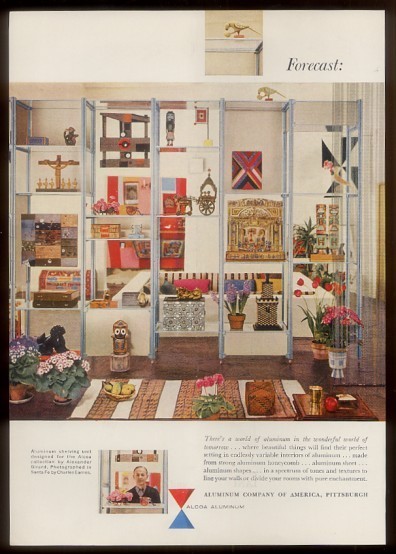
But I just stumbled across this tearsheet on eBay, which is probably from the July 27, 1957 issue of the New Yorker, and which shows a shelving system Alexander Girard designed for the Alcoa Forecast campaign. The photo, shot in Santa Fe, at Girard’s house, was taken by Charles Eames. Which, according to the timeline of John Neuhart, the Eames employee who actually created it, is about when the Solar Do-Nothing Machine was realized.

So Girard. Hmm. Overall, of course, awesome. But the shelves themselves? I gotta say, I’m not feeling it. The various panels in milk or smoked glass are fine, but the tubular metal seems off, and the feet are a mess.
The image itself seems to be more successful, or interesting, the way it collapses background and foreground into the shelves, which is funny, since they’re ostensibly meant to divide the space they inhabit, not flatten it. That Four Seasons-looking chain curtain thing on the right is especially odd/cool. And that Mary Heilmann painting top-center is freaking awesome.
Category: new yorker magazine database
Italian Line, Farm Journal
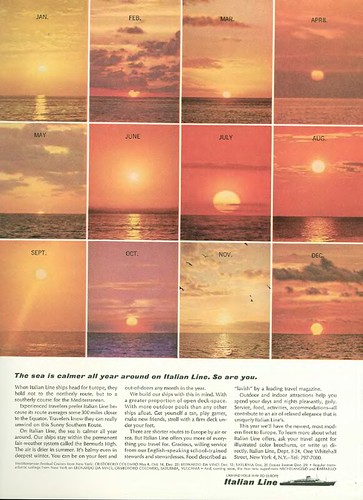
The New Yorker obsoleted my old New Yorker Magazine Database by finally letting Google index their website and adding a search function, and making their archive available online, and that’s as it should be.
But whenever I browse the DVD facsimile of the magazine’s archive, I am reminded of how much content remains unindexed and invisible. So maybe it’s time to liberate the vintage ads of the world from their back issue prisons. Because if I can find ads this awesome completely at random, don’t you wonder what else is out there?
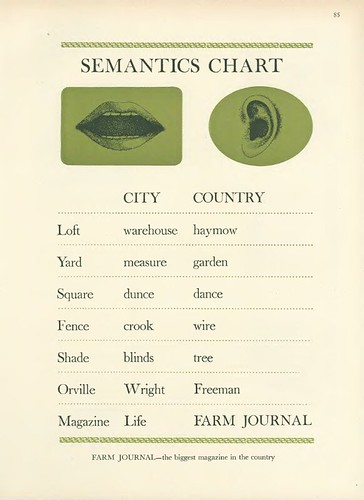
Haymow!
‘If Echo were as fleet…’

Paul Brodeur in Talk of the Town, The New Yorker, September 3, 1960. The abstract pretty much captures the whole, short piece:
Comment on attending Shakespeare’s “The Taming of the Shrew” at Central Park’s outdoor Belvedere Lake Theatre.
We noticed that many of our fellow-theatre-goers were gazing upward at the stars & summer haze of the night sky…& we followed suit. With the opening lines, we realized that they were still lost in the galaxies overhead. We again directed our attention to the stage. The lord was saying, “Thou art a fool. If Echo were as fleet, I would esteem him worth a dozen such…” & suddenly, brought rigid by the unwitting bard, we turned our gaze aloft, where, shining majestically in sunlight beyond the pale of our night, Echo 1 floated in the west. For many minutes, as the satellite traveled toward its northeast solstice, we sat with tilted head, our spirit swiveling between past myth & future myth. Then, unraveling ourself from our involvement with Echo’s awesome journey, we returned to the bleachers at the Belvedere, and thence to Shakespeare’s Padua, filled with reborn wonder at the mastery of man.
And it turns out Calvin Tomkins himself did a long profile in 1963 of Dr John Pierce, who oversaw Project Echo at Bell Labs. Tomkins seems to focus on what I find most mind-blowing about the Echo satelloons: the whole thing was undertaken by a tiny, informal group, without a giant industrial-scale infrastructure. It was almost ad hoc and bricolage, something akin to making, not manufacturing.
Not sure when I’m going to have the time to read that…
image: a 40-second time lapse from Autumn 1960 of the Echo I satelloon in orbit, published in an extensive “making of/launching of” article in the January 1961 issue of Popular Science magazine.
The Fake Wedding Singer
Even he had to admit that this was as pleasant a concert setting as could be imagined. The stage was a flatbed trailer set up in front of a log cabin; it was a breezy summer afternoon, and people brought folding chairs and beach blankets. His mother was there, with a collection of aunts and uncles. Parsons, shirtless in swimming trunks and as skinny as advertised, sang some charming, shambling mountain songs with his band, and then there was a fake marriage ceremony, in case the neighbors were watching–they had been told that the gathering was for a wedding, on the theory that this would make them less likely to call the police. Then Oldham took the stage, with Parsons and the band surrounding him. He was wearing a maroon tank top, orange-and-pink pants, blue Crocs, and a pink Boston Red Sox cap, with “cam” and “odia” scrawled on either side of the “B.”
– Will Oldham transfigures American music, by Kelefah Sanneh [newyorker.com via southwillard]
Lego City Of The Future, By Norman Mailer & Friends
If you had to name one American, for instance, who clubbed together with a couple of friends in 1965 and spent more than three weeks building a futuristic seven-foot vertical city out of Lego, you might not immediately think of Norman Mailer. Thirty-three years later, however, the city still stands in Mailer’s living room in Brooklyn Heights, and its creator remains enthusiastic about his project. “It was very much opposed to Le Corbusier. I kept thinking of Mont-Saint-Michel,” he explains. “Each Lego brick represents an apartment. There’d be something like twelve thousand apartments. The philosophers would live at the top. The call girls would live in the white bricks, and the corporate executives would live in the black.” The cloud-level towers, apparently, would be linked by looping wires. “Once it was cabled up, those who were adventurous could slide down. It would be great fun to start the day off. Put Starbucks out of business.”

Last fall after he died, the fate of Norman Mailer’s Lego “City of The Future,” which stood in his living room for more than 40 years, was not publicly disclosed.
I wondered what it looked like. Turns out, it probably looks a lot like the photograph of it by Simeon C. Marshall, which accompanied The New Yorker article on Lego from which the above quote was taken.
update: Basically, awesome.
This photo was used on the cover of Mailer’s 1966 essay collection, “Cannibals and Christians.” The city itself was Mailer’s own proposal for dealing with the looming crisis of sub/urban sprawl: “If we are to avoid a megalopolis five hundred miles long, a city without shape or exit, a nightmare of ranch houses, highways, suburbs and industrial sludge,” he wrote in a 1964 essay in Architectural Forum, “then there is only one solution: the cities must climb, they must not spread, they must build up, not by increments, but by leaps, up and up, up to the heavens.” Thus, the Lego city. [quote via arcchicago]
In Mary Dearborn’s Mailer: A Biography, the construction of the Lego City is portrayed as nothing less than a bold attempt by the author “to make a revolution in the consciousness of our time”–if only they could’ve gotten it out of the writer’s living room:
In many ways this was a typically Mailerian project. He announced it in advance in the pages of the New York Times Magazine and, to underline his seriousness, in Architectural Forum. The prose city he outlined would change the face not only of public architecture but of society itself. He had long blamed architecture for many of the woes of contemporary society, and now he applied himself to setting forth his plans in pronouncements and, beginning in the fall of 1965, the creation of an actual model city, immense in scale and meticulously planned.
…
He decided to build a model of a city that could be populated by 4 million people, and to build it in his own living room. He conceived it as a monument to his sweeping utopian vision.
At the quotidian level, Norman acted as the brains behind the project, soon discovering that he didn’t like the sound of the plastic Lego pieces snapping together; it struck him as vaguely obscene. He delegated the task to [fourth wife] Beverly’s stepbrother, Charlie Brown, who worked as a kind of handyman for him, and to Eldred Mowery, a friend from Provincetown now in the city. The two men drove Norman’s 1961 blue convertible Falcon out to the Lego plant in New Jersey and returned with cases of the colored blocks. Then Norman directed them, instructing them to create hanging bridges, buildings with trapdoors, and four-foot-high towers, all constructed on an aluminum-covered piece of plywood on a four-by-eight-foot sheet of plywood supported by five-foot legs.
Construction proceeded apace, and Norman never really did call a halt to it. But someone from the Museum of Modern Art came out to Brooklyn to take photographs of the model, hoping to display it at the museum. At that point, Mailer and his helpers found that the “city” could not be taken out of the apartment. though they consulted movers with cranes and took measurements of the glass in the front windows, they soon saw that it couldn’t be removed without being disassembled first. Here Norman drew the line. He told Mowery to build a fence around it and leave it where it was. There it still sits, occupying a third of the living room’s floor space. Beverly, who contributed a scale model of the United Nations to indicate the overall scale of the city, professes that she loved it, but concedes, “It was a bitch to dust.”

That must be the UN in the lower left corner there. As so often happens to builders of utopian Cities of The Future, Eldred Mowery was arrested several months later in an art insurance scam. Seems that in December 1966, he and an artist/carpenter friend broke into the Provincetown cottage of painter Hans Hoffman and made off with 41 paintings, which they tried to return to the insurance company for a reward. Only instead of insurance company executives, they handed the works over to undercover FBI agents.
Any photos or documentation in MoMA’s archives remains to be explored.
The Joy of Bricks by Anthony Lane, Apr 2, 1998 [newyorker.com]
Apparently some brickers sussed out the photo last December, too[brothers-brick.com]
Mailer: A Biography, by Mary V. Dearborn [google books]
Buy Cannibals and Christians on AbeBooks [abebooks]
Morton Feldman & The Man On The Street
A quote from Morton Feldman, reprinted in Alex Ross’s excellent piece on the modernist composer:
My teacher Stefan Wolpe was a Marxist and he felt my music was too esoteric at the time. And he had his studio on a proletarian street, on Fourteenth Street and Sixth Avenue. . . . He was on the second floor and we were looking out the window, and he said, “What about the man on the street?” At that moment . . . Jackson Pollock was crossing the street. The crazy artist of my generation was crossing the street at that moment.
I came to Feldman’s music through his association with John Cage; several Cage concert series over the last few years have included Feldman’s work as well. But Ross’s write up of “Rothko Chapel” makes me wish I lived near a 24-hour classical music CD store so I could listen to it right now.
AMERICAN SUBLIME Morton Feldman’s mysterious musical landscapes. [newyorker.com]
Morton Feldman: “Rothko Chapel; Why Patterns?” on New Albion [amazon.com]
2005-12-05, This Week In The New Yorker
![]() Issue of 2005-12-05
Issue of 2005-12-05
Posted 2005-11-28
THE TALK OF THE TOWN
COMMENT/ FLOOR WAR/ Hendrik Hertzberg on the war over the war in Congress.
BEIJING POSTCARD/ POPPY, SHOPPING/ Peter Hessler traces the steps of Old Bush.
VISITING DIGNITARIES/ GIBBONS/ Nick Paumgarten meets the lead guitarist of ZZ Top.
TEXTURE DEPT./ WALING/ Ben McGrath attends a meeting of the Corduroy Appreciation Club.
MOONLIGHTING DEPT./ MOB APPEAL/ Lauren Collins on a best-selling prosecutor.
POSTSCRIPT/ CECILLE SHAWN/ Remembering the wife of the late New Yorker editor William Shawn.
ANNALS OF NATIONAL SECURITY/ Seymour M. Hersh/ Up in the Air/ Bush’s intransigence and the coming air war.
SHOUTS & MURMURS/ Bruce McCall/ Getting Started
FICTION/ Alice Munro/ “Wentlock Edge”
THE CRITICS
BOOKS/ Adam Kirsch/ Strange Fits of Passion/ Wordsworth’s revolution.
BOOKS/ Louis Menand/ Everybody’s an Expert/ Putting predictions to the test.
THE THEATRE/ John Lahr/ Bleak House/ A child’s fantasy life and a failed inventor Off Broadway.
THE ART WORLD/ Peter Schjeldahl/ In the Mood/ New works by Gerhard Richter.
MUSICAL EVENTS/ Alex Ross/ The Evangelist/ David Robertson lifts up the St. Louis Symphony.
THE CURRENT CINEMA/ David Denby/ Company Man/ “Syriana.”
FROM THE ARCHIVE
DAYTON, TENNESSEE/ Marquis James/ A Summary/ A 1925 report on the Scopes monkey trial, in which a teacher stood accused of teaching evolution in school.
2005-10-24, This Week In The New Yorker
![]()
Issue of 2005-10-24
Posted 2005-10-17
THE TALK OF THE TOWN
COMMENT/ GAME PLAN/ George Packer on what the Republicans’ troubles mean for the opposition.
NOSEBLEED DEPT./ RARE AIR/ Nick Paumgarten visits an office with altitude.
WHO R U?/ HARRIET 4 JUSTICE/ Mark Singer trades thoughts with Harriet Miers’s alter ego.
GOOD WORKS/ BED BATH & BOWERY/ Lauren Collins on the best-friend benefactors of the New Museum.
EVERYBODY’S AN EXPERT/ DRAWING PITCHERS/ Michael Rosenwald on an illustrator with a secret.
SHOUTS & MURMURS/ Bruce McCall/ Only cronies need apply.
THE CRITICS
BOOKS/ Jill Lepore/ People Power/ Revisiting the origins of American democracy.
BOOKS/ H. Allen Orr/ Turned On/ A revolution in the field of evolution?
ON TELEVISION/ Nancy Franklin/ Big Mac/ At long last, a woman in the White House.
MUSICAL EVENTS/ Alex Ross/ Fresh Faces/ City Opera’s fall season.
DANCING/ Joan Acocella/ Paper Tiger/ Michael Flatley in a new step-dancing extravaganza.
THE CURRENT CINEMA/ David Denby/ Family Matters/ “The Squid and the Whale” and “Elizabethtown.”
FROM THE ARCHIVE
http://www.newyorker.com/fact/content/articles/050228fa_fact1″>A REPORTER AT LARGE/ Michael Specter/ NATURE’S BIOTERRORIST/ Is there any way to prevent a deadly avian-flu pandemic?/ Issue of 2005-02-28
One week of The New Yorker not enough for you? How about 80 years worth? Buy The Complete New Yorker, an 8 DVD-ROM set and companion book complete with every page of the magazine, ever, through last September, at Amazon.
So You Want To Read “Brokeback Mountain”
I shouldn’t be surprised that I’m getting this question a lot these days. Here’s what Ang Lee told the NYT’s Karen Durbin:
“When I first read the story, it gripped me. It’s a great American love story, told in a way that felt as if it had never been done before. I had tears in my eyes at the end. You remember? You see the shirts put away in the closet side by side.”
Who could forget? When Annie Proulx’s short story about two cowboys in love appeared in The New Yorker nearly eight years ago, it was so startling and powerful that for many people, the experience of reading it remains a vivid, almost physical memory.
The movie just won the Golden Lion at the Venice Film Festival, and had its North American debut at the Toronto Festival last week. The theatrical release is expected in December, which gives you enough time to track down a copy of Brokeback Mountain yourself.
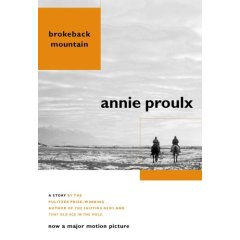
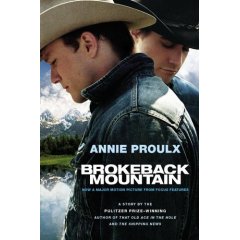
Here’s where it is:
Here’s where it isn’t:
A slightly bowdlerized version of the text was posted last summer on a message board at heathbaby.com, but has since been taken down. If you try Googling a distinctive phrase [like, say, “They shook hands in the choky little trailer office,”] you might find it, though. [unbelievable-but-true update via towleroad: Amazon published the complete story as an excerpt for an out-of-print audio version of Close Range.]
And just like that, his dream of amassing a mountain of quarters from Amazon commissions burns off like morning dew on the alfalfa field.
Ang Lee: Master of Social Mores [nyt via iht]
Official filmsite: Brokebackmountain.com
Finally, New Yorker Articles Via RSS
Google News started indexing The New Yorker, and using this link, you can see the links of up to 100 articles from the magazine. Right now, that covers stuff back to July 31.
+the source:new_yorker, also available via rss and atom [Google News, via robotwisdom]
2005-07-25, This Week In The New Yorker
![]()
Issue of 2005-07-25
Posted 2005-07-18
THE TALK OF THE TOWN
COMMENT/ NOT SCARED/ Adam Gopnik on the mood in London on the day of the bombings.
MIRROR, MIRROR/ FACE-OFF/ Ben McGrath on what we might see in a candidate’s countenance.
DEPT. OF TRYOUTS/ LOW NOTES/ Ryan D’Agostino on the search for a new bass player at the Met.
SPINOFF DEPT./ REPORTER GUY/ David Remnick on Stephen Colbert’s new fake-news show.
THE FINANCIAL PAGE/ A FAREWELL TO ALMS?/ James Surowiecki on how foreign aid is administered.
VATICAN NOTEBOOK/ Anthony Grafton/ Reading Ratzinger/ What the Pope’s theological writings reveal.*
SHOUTS & MURMURS/ Noah Baumbach/ My Dog Is Tom Cruise
ANNALS OF NATIONAL SECURITY/ Seymour M. Hersh/ Get Out the Vote/ Did Washington campaign in Iraq’s election?
A REPORTER AT LARGE/ William Finnegan/ The Terrorism Beat/ Inside the city’s defense command centers.*
ANNALS OF MEDICINE/ John Colapinto/ Bloodsuckers/ Leeches are good for you after all.*
FICTION/ Tobias Wolff/ “Awaiting Orders”
THE CRITICS
BOOKS/ James Wood/ Red Planet/ The sanguinary sublime of Cormac McCarthy.
BOOKS/ Joan Acocella/ Devil’s Work/ Hilary Mantel’s ghosts.
DANCING/ Joan Acocella/ Recovered Treasure/ Frederick Ashton’s “Sylvia” and George Balanchine’s “Don Quixote.”
THE CURRENT CINEMA/ Anthony Lane/ Making Mischief/ “Charlie and the Chocolate Factory,” “Wedding Crashers.”
* Not currently online.
Subscribe to the New Yorker via Amazon
The REAL New Yorker Magazine Database
Wow. The New Yorker will publish its entire archive, indexed and searchable, on DVD this fall for $100 MSRP. [NYT, via kottke]
Amazon’s already taking pre-orders for $63.
2005-05-23, This Week In The New Yorker
![]()
Issue of 2005-05-23
Posted 2005-05-16
THE TALK OF THE TOWN
COMMENT/ BLAIR’S BUSHY TAIL/ Hendrik Hertzberg on Tony Blair’s shrinking majority.
DEPT. OF YESTERYEAR/ U.N. ON ICE/ Nick Paumgarten on the U.N.’s potential move to the outer boroughs.
STREET LIFE/ TREE COUNT/ Andy Young on cataloguing Manhattan’s flora.
ICONS/ MR. G./ Adam Green on Robert Goulet, at seventy-one.
DEPT. OF INSPIRATION/ WRITERS AT WORK/ Ben McGrath on special work spaces for writers, in Queens.
A REPORTER AT LARGE/ Michael Specter/ Higher Risk/ Why H.I.V. rates are rising among gay men.
SHOUTS & MURMURS/ Paul Rudnick/ A Mother’s Story
THE SPORTING SCENE/ Ben McGrath/ Teen Spirit/ The trials of being an American soccer star.
ANNALS OF ESPIONAGE/ Thomas A. Bass/ The Spy Who Loved Us/ The double life of a Vietnamese patriot.
PROFILES/ Calvin Tomkins/ Everything in Sight/ Robert Rauschenberg’s big new work.
FICTION/ Jonathan Franzen/ “Two’s Company”
THE CRITICS
BOOKS/ Joshua Micah Marshall/ National Treasure/ In the year 1776, character was destiny.
IN FASHION/ Judith Thurman/ Scenes From a Marriage/ The House of Chanel at the Met.
ON TELEVISION/ Nancy Franklin/ Magical Mystery Tour/ Forty-eight castaways win the prime-time challenge.
THE CURRENT CINEMA/ Anthony Lane/ Space Case/ “Star Wars: Episode III.”
FROM THE ARCHIVE
THE CURRENT CINEMA/ Galaxy Crisis/ Penelope Gilliatt/ A consideration of the human fascination with extraterrestrial life, complete with an R2-D2 namecheck/ Issue of 1977-06-13
THE CURRENT CINEMA/ Contrasts/ Pauline Kael considers the first “Star Wars” [wait, almost four months later? slacker. -greg]/ Issue of 1977-09-26
Subscribe to the New Yorker via Amazon
2005-04-18, This Week In The New Yorker
![]()
Posted 2005-04-11
Issue of 2005-04-18
THE TALK OF THE TOWN
COMMENT/ WASTED ENERGY/ Elizabeth Kolbert on the fight over drilling in Alaska.
DEPT. OF MERGERS/ WINNERS/ Rebecca Mead reports from Mr. and Mrs. Jack Welch’s book party, at the Four Seasons.
DEPT. OF NOISEMAKING/ THE ANGRY INVESTOR/ Ben McGrath on Daniel Loeb and what complaint letters will get you.
LEGACIES/ THE NUT LADY RETURNS/ Tad Friend on a showdown in the Nutmeg State.
THE FINANCIAL PAGE/ IN YUAN WE TRUST/ James Surowiecki on where America’s currency is headed.
OUR FAR-FLUNG CORRESPONDENTS/ Tad Friend/ The Parachute Artist/ How Lonely Planet changed travel.
FICTION/ Ludmila Ulitskaya/ “The Orlov-Sokolovs”
ARE WE THERE YET?
Nicole Krauss/ My Summer in Poland
Jonathan Franzen/ Countdown
Jane Smiley/ Cold Front
Mary Gordon/ Pilgrimage
THE CRITICS
BOOKS/ Joan Acocella/ Piecework/ The writings of Sybille Bedford.
BOOKS/ Steven Shapin/ Cleanup Hitters/ The steroid wars and the nature of what’s natural.
THE THEATRE/ Hilton Als/ The Many Faces of Jane/ A one-woman show about the life of Djuna Barnes.
MUSICAL EVENTS/ Alex Ross/ Off the Rails/ A rare performance of Harry Partch’s “Oedipus.”
THE CURRENT CINEMA/ David Denby/ Track and Field/ “Kontroll” and “Fever Pitch.”
FROM THE ARCHIVE
A CRITIC AT LARGE/ Philip Roth/ Rereading Saul Bellow/ Issue of 2000-10-09
BOOKS/ Joan Acocella/ Finding Augie March/ Saul Bellow’s first novels./ Issue of 2003-10-06/ Posted 2003-09-29
FICTION/ Saul Bellow/ “A SILVER DISH”/ Issue of 1978-09-25
Subscribe to the New Yorker via Amazon
The New Yorker Masthead Database
While I’m lackadaisically culling archival links from the New Yorker’s website (to make up for the fact that they have no search or archive function), the New York Observer has emptied the scribbled-on scraps of paper and cocktail napkins from their pockets to piece together a nearly complete masthead for the magazine (to make up for the fact that they have none).
1) Is there anything else you need done, New Yorker? Can we pick up your cleaning, water your plants, glue in your perfume strips?
2) There’s no one in charge of squelching run-on sentences, either at the New Yorker or (more obviously) here.
3) Is Andrea Scott no longer doing the art section for Goings On About Town? [making hand-as-phone gesture and mouthing ‘call me, Andrea.’]
Our Far-Flung Staff [Observer.com]
